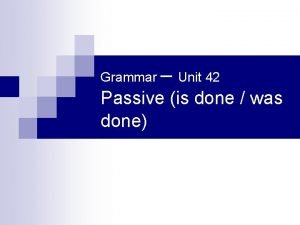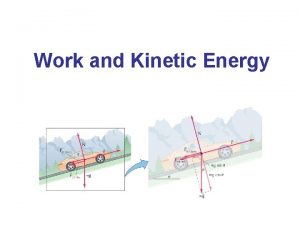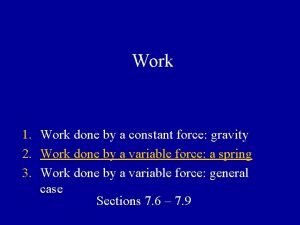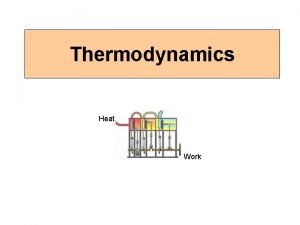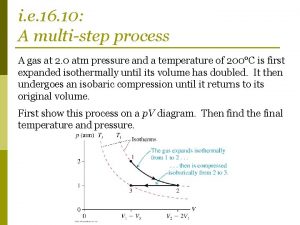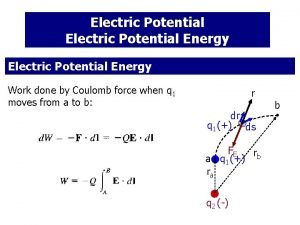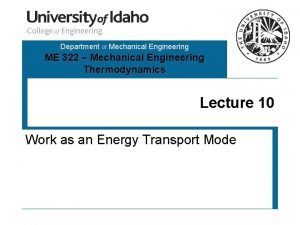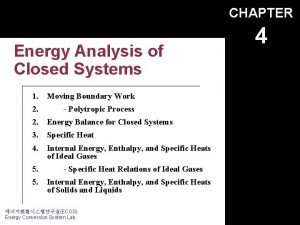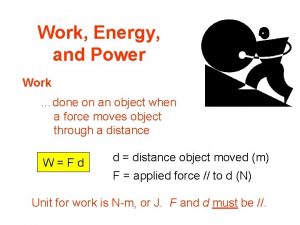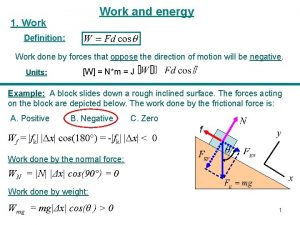Understanding Work Energy Power Efficiency Energy Work done























- Slides: 23

Understanding Work, Energy, Power & Efficiency

Energy

Work done is equal to the amount of energy transferred. Forms of energy: 1. Kinetic energy 2. Gravitational potential energy 3. Elastic potential energy 4. Sound energy 5. Heat energy 6. Light energy 7. Electrical energy 8. Chemical energy

Energy – Work Done When energy changes from one form to another, Work is done. Energy transfer when the work is done.

Examples A student pushes a trolley of books. Chemical energy stored in the body of the student is transferred to the trolley as kinetic energy. The farmer lifting a bag of rice onto the lorry transfer energy to the bag as gravitational potential energy.

Only moving objects possess kinetic energy.

The kinetic energy of the object is the same as the work done to change the velocity of the object from 0 m s-1 to v m s-1.

Initial velocity, u = 0 m s-1 Final velocity, v = v m s-1 From equation of linear motion: Displacement, s = s m V 2 = u 2 + 2 as Work done, W = F x s = m a s S = (v 2) / 2 a W = ma (v 2/2 a) W = ½ m v 2 The kinetic energy, Ek of an object of mass, m kg traveling at a velocity of v m s-1 is given as: Ek = ½ m v 2

EXAMPLE 1 A car of mass 950 kg accelerates from a velocity of 20 m s-1 to a velocity of 35 m s-1. What is the work done for the car to accelerate? v = 35 ms-1 Solution: m = 950 kg, u = 20 ms-1, v = 35 ms-1 Work done, W = Change in kinetic energy of the car W = Final Ek – Initial Ek W = ½ mv 2 – ½ mu 2 = ½ m (v 2 -u 2) W = ½ x 950 ms-1 x (35 ms-1 – 20 ms-1) = 391875 J

EXAMPLE 2 What is the kinetic energy of a man of mass 65 kg jogging at a velocity of 3 m s-1 Solution Mass, m = 65 kg, velocity, v = 3 m s-1 Kinetic energy, Ek = ½ mv 2 Ek = ½ x 65 kg x (3 m s-1)2 Ek = 292. 5 J


When an object of mass, m kg is raised to a height, h meters above the earth’s surface, the object possesses gravitational potential. box h The gravitational potential energy is equal to the work done to raise an object to a particular height. Work done, W = F x s W = mgh Gravitational potential energy, Ep = W Ep = mgh

EXAMPLE 1 Figure below shows a box of weight 50 N being pulled up on a smooth inclined plank by a force of 25 N from A to B. box 25 N 4 m B F= 50 N h=2 m 30 o A a. Calculate the work done by the 25 N force. b. What is the work done against gravity? c. State the value of the gravitational potential energy of the box at B.

EXAMPLE 2 Calculate the gravitational potential energy in respect of each of the following. m = 2 kg h = 1. 2 m Solution Potential energy of weight, Ep = mgh Ep = 2 kg x 9. 8 ms-2 x 1. 2 m Ep = 23. 52 J

The total amount of energy always remains the same.


EXAMPLE 1 In a softball game, a ball was miss hit and flew vertically upwards with an initial velocity of 15 ms-1. what is the maximum height attained by the ball? Solution If air resistance is neglected, we can assume that the kinetic energy of the ball is changed to gravitational potential energy only. ½ m v 2 = mgh ½ x m x (15 ms-1) 2 = m x 9. 8 ms-2 x h h = (15 ms-1)2 / (2 x 9. 8 ms-2) h = 11. 48 m

EXAMPLE 2 A durian of 2. 5 kg falls from a height of 12 m to the ground. a. What is the loss of potential energy when the durian is 4 meters above the ground? b. Calculate the velocity of the durian at this height. Solution a. Loss of potential energy = m g (12 m) – m g (4 m) a. = m g (12 m – 4 m) = 2. 5 kg x 9. 8 ms 2 b. x 8 m = 196 J b. Gain in kinetic energy = Loss of potential energy c. = 196 J d. ½ x 2. 5 kg x v 2 = 196 J e. v 2 = (2 x 196 J) / (2. 5 kg) = 156. 8 f. v = 12. 5

Quiz

Calvin rides his bicycle down the slope of a hill 3 m high at an initial velocity of 2 m s-1, without pedaling. At the foot of the hill, the velocity is 6 m s-1. given that the mass of Calvin with his bicycle is 75 kg, find a. The initial kinetic energy of the bicycle, b. The initial potential energy of the bicycle, c. The work done against friction along the slope. u = 2 m s-1 v = 6 m s-1 3 m

Solution a. Initial kinetic energy, Ek = ½ m u 2 Ek = ½ (75 kg) x (2 m s-2) = 150 J b. Initial potential energy, Ep = mgh Ep = (75 kg) x (9. 8 m s-2) x (3 m) Ep = 2205 J c. Kinetic energy at the foot of the hill, Ek = ½ m v 2 Ek = ½ (75 kg) x (6 m s-1)2 Ek = 1350 J Work done against friction along the slope, W = total initial energy – kinetic energy at the foot of the hill W = (150 + 2205) – 1350 W = 2355 – 1350 = 1005 J

Summary

 Work power and efficiency
Work power and efficiency Allocative efficiency vs productive efficiency
Allocative efficiency vs productive efficiency Productively efficient vs allocatively efficient
Productively efficient vs allocatively efficient Productively efficient vs allocatively efficient
Productively efficient vs allocatively efficient Unit 42 passive 1
Unit 42 passive 1 Principle of cutter mill
Principle of cutter mill Sen bir koyun olsan bende bir kuzu sözleri
Sen bir koyun olsan bende bir kuzu sözleri Understanding the efficiency of ray traversal on gpus
Understanding the efficiency of ray traversal on gpus Work done and kinetic energy
Work done and kinetic energy Renewable energy and energy efficiency partnership
Renewable energy and energy efficiency partnership The real lesson 21
The real lesson 21 Natural gas power plant efficiency
Natural gas power plant efficiency Ratio of useful energy to total input energy
Ratio of useful energy to total input energy Which power amplifier has the highest collector efficiency
Which power amplifier has the highest collector efficiency Intelligent sharing of power is done among:
Intelligent sharing of power is done among: The work done by gravity during the descent of a projectile
The work done by gravity during the descent of a projectile Work done pressure volume
Work done pressure volume Isothermal work
Isothermal work Work done by charge
Work done by charge Work done in polytropic process
Work done in polytropic process Site:slidetodoc.com
Site:slidetodoc.com Work done in polytropic process
Work done in polytropic process Adiabatic process work done
Adiabatic process work done Define energy work and power
Define energy work and power




